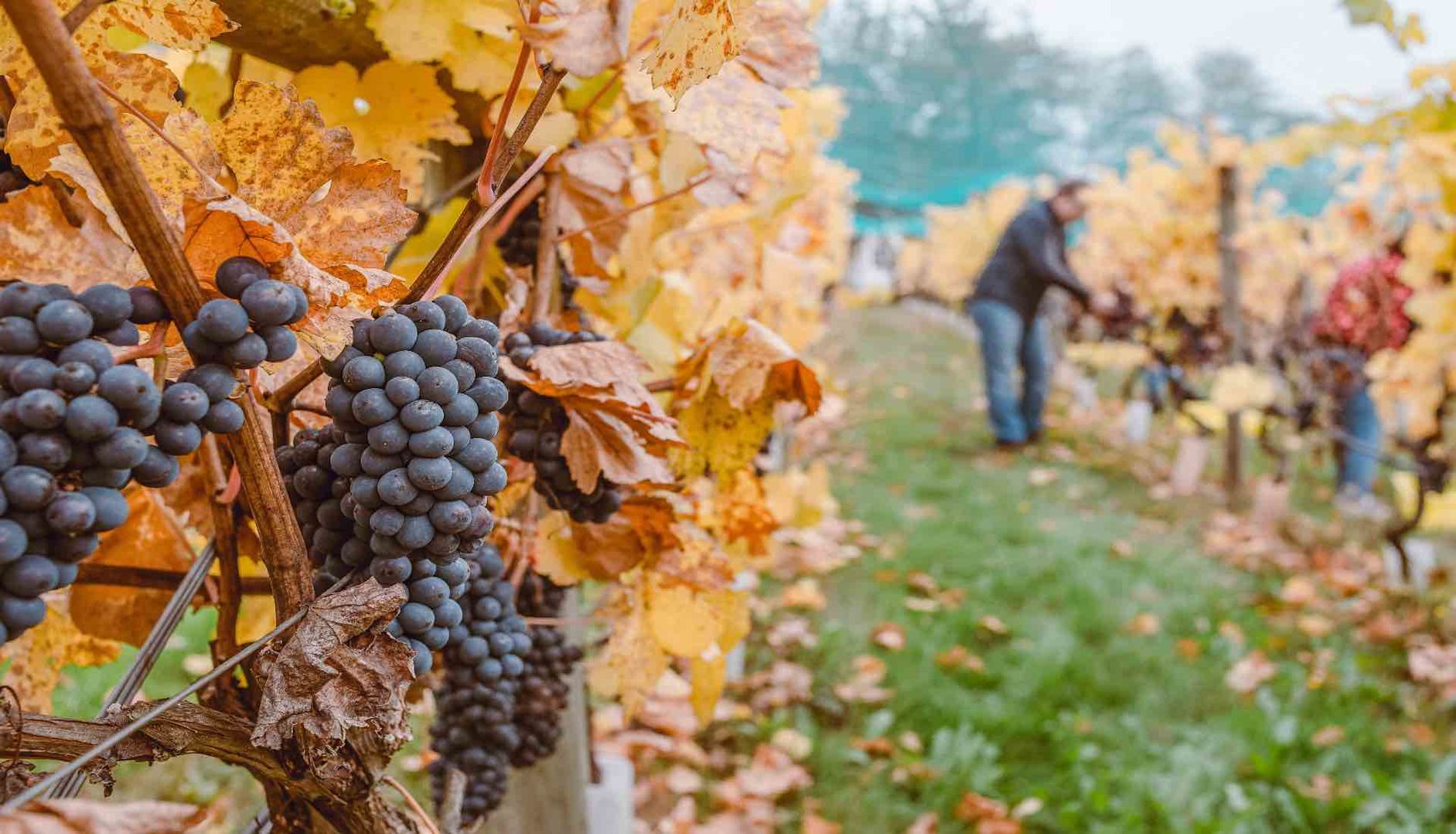Chat with Vinny
Not for nothing is Pinot Noir known as the ‘heartbreak grape’. Top bottles can be heartbreakingly expensive. And if you’re unlucky, it can heartbreakingly disappointing. Yet it can also be heartbreakingly good – the most seductive, silky and graceful wine you could ever sip. Read on to find out why.
What is Pinot Noir?
The World Atlas Of Wine calls Pinot Noir “the most elusive grape”. But given that you can probably pick up a bottle at your local supermarket (and you’ll find a wide selection on our website) what can they mean?
Yes, you can get simple, fruity Pinot Noir – from Chile, for example. But no other grape can reach the level of mystery, awe, or mythology as Pinot Noir at its finest. Because, given the right conditions, (such as the Grand Cru vineyards of Burgundy) it delivers sublime reds that are silky, sexy, fruity, bold and complex.
Which is why it remains one of the most sought-after red wines in the world.

What does good Pinot Noir smell and taste like?
Let’s have a look, sniff and sip.
Colour: Pinot Noir wines tend to be lighter in colour compared to other red wines. Depending on the growing conditions and winemaking practices, it can range from a pale ruby to a deeper garnet.
Aroma: Pinot Noir typically presents a complex bouquet of aromas, including red fruits like cherries, raspberries, and strawberries, often mingled with earthy undertones of forest floor, mushrooms, and herbs. With age, these wines can develop more nuanced scents, such as game, leather, and truffle.
Flavour: Pinot Noir is typically dry, light- to medium-bodied, with bright acidity, silky tannins and alcohol that ranges between 12–15%. You will enjoy complex flavours that include cherry, raspberry, mushroom and forest floor, plus vanilla and baking spice when aged in French oak.
Remember, the taste of your Pinot Noir will vary depending on climate and producer style. Cooler climates produce more delicate and light-bodied Pinot Noir. Warmer climates produce riper and fuller-bodied Pinot Noirs with higher alcohol.
How do you pick a good Pinot Noir?
To pick a good Pinot Noir – and one that suits your tastes – you need to know a little more about this temperamental grape.
For starters, Pinot Noir is something of a ‘diva’. Not only is it fussy about where it grows, but it rarely shares the centre stage with any other grape. One notable exception is Champagne (a special occasion if ever there was one). There Pinot Noir is prepared to share top billing with Chardonnay and Pinot Meunier in such superstar fizzes as Dom Perignon, Krug and Bollinger.
And what’s more, like many a diva, Pinot Noir has a very thin skin.

This is important: as both a challenge and an advantage. For example, the thin skin makes the Pinot Noir grapes vulnerable to sunburn and other forms of damage from hot weather. The grapes need careful canopy management to ensure that they receive just the right amount of sunlight and protection.
On the other hand, the thin skin allows the grapes to express their unique terroir: to reflect the climate, soil, topography, and cultural nuances of where it is grown. To make matters harder still, Pinot Noir grapes are also highly sensitive to their growing conditions. They prefer well-draining, slightly acidic soil and a cool climate with moderate temperatures.
Overall, Pinot Noir requires a great deal of care and attention in the vineyard to produce high-quality grapes, which is one of the reasons it is highly prized among winemakers and wine lovers. Because get it right and, as we’ve said, it’s ‘Holy Grail’ good. So, let’s go on a quick Pinot Noir world tour…
Where are the famous Pinot Noir regions – and what are their characteristics?
Pinot Noir is grown throughout the world – but the best come from quite specific spots.
You’ll find it worthwhile to visit regions like California and Oregon in the US, and countries like Chile, New Zealand (in particular Central Otago), and Germany (where it is known as Spätburgunder). But the undisputed king of Pinot Noir is France, and in particular, the region of Burgundy.

Pinot Noir from Burgundy and the Cote d’Or
Burgundy is bewildering. There are nearly 100 appellations here based around a rather commonplace looking ridge – the Cote d’Or – that makes far from common place wines. Wine quality has been studied here since the 12th century, resulting in some of the most expensive and sought after bottles on the planet.
What are the quality levels of Pinot Noir from Burgundy?
Thankfully, quality levels in of Pinot Noir in Burgundy are relatively easy to understand.
Regional wines – labelled Burgundy AOC, these entry level wines can be made with grapes from across the Burgundy region. A great introduction to the style.
Village wines – these are from named villages such as Pomerol or Volnay, and already can offer a pretty big step up in quality from regional wines
Premier Cru – wines made from named vineyards that are deemed to produce consistently fine wines. Premier Cru Burgundy reds are among the finest Pinot Noirs you’ll taste.
Grand Cru – wines from the very top vineyards in Burgundy – legendary names such as Clos Saint-Denis and Corton Charlemagne that are spoken of by collectors in awed whispers
What does Pinot Noir from Burgundy taste like?
Burgundian tends to be medium-bodied and fresh, with flavours of cherry, black plum, leafy tobacco, and even subtle spice.
Pinot Noir in Australia
For the best Pinot Noir in Australia, head to the cooler climate areas of Victoria and Tasmania.
Pinot Noir from Victoria’s Yarra Valley tends to be light-bodied and very approachable, with supple berry flavours laced with more complex notes of soft spice and earthier notes of mushroom and leaf.
The island state of Tasmania is also home to dozens of fine-wine-producing wineries, particularly in its Tamar Valley, Pipers River, and Coal River Valley regions. Common flavours here include dark plum and raspberry, alongside notes of cherry, delicate spice, and earthier tones of mushroom.

Pinot Noir in New Zealand
Detractors might call them ‘fruit bombs’ …
But if you are looking to discover Pinot Noirs packed with red fruit and vibrancy, head to New Zealand. The long growing season and moderate heat help the grapes can retain their acidity, making Pinot Noirs that, while they may be fruity, have a subtle power and finesse similar to a Burgundian Pinot.
Although Pinot Noir was first planted in New Zealand in 1883, it didn’t really find traction with either producers or consumers until more than a century later. But today Pinot Noir is the country’s top red grape variety by far. Head to Central Otago for perhaps the finest. Here, they produce Pinot Noir that is fresh and elegant, complex and structured, with a textural component that speaks to a specific sense of place.
Food pairings with Pinot Noir: what works and what doesn’t?
The best food pairings for Pinot Noir complement the wine’s pretty fruit flavours, bright acidity and elegant style. Think lighter red meats like duck and lamb, or white meats like turkey, pork and chicken. Meaty fish, like salmon, also pair well with Pinot Noir, as do earthy vegetables. Herbs like mushrooms and thyme match the wine’s savoury flavours, especially when folded into risotto and pasta. Pairings to avoid with Pinot Noir? Anything dense and richly flavoured that can overpower the delicacy of the wine.

About the author
Richard Bull
Although good at running up hills, Richard failed to make the military cuvée and turned instead to the drinks trade. After stints at Hennessy, Oddbins and Grants of St James, he arrived at Laithwaites. Here, he spent 15 years writing about real wine and the people who make it. As he wrote from the desk to your door, he was lucky enough to visit vineyards in France, Italy, Spain and Kent - as well as being flown over South Africa's Breede River by a winemaking army veteran who'd just had a heart attack. Qualified to WSET Level 3, he loves the off-the-beaten track reds of the Languedoc, but is currently obsessed with all drops Greek - particularly their super crisp whites.

